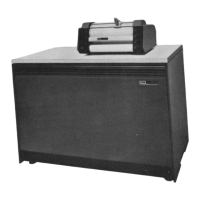Error
Checks
60
and
a fractional part.
The
integral
part
becomes
the
characteristic of
the
result;
the
fractional
part
is
evaluated
in
the
polynominal to
produce
the
mantissa.
When
the
argument
of
the
function is positive,
the
error
in
the
result does
not
exceed one
in
the
last digit of
the
mantissa;
when
the
argument
is negative,
the
limit of error
is five in
the
last digit of
the
mantissa.
FAXB and FAXBN:
AB
is evaluated as e
B1n
\ therefore,
it
is evaluated
by
means of
three
linking subroutines,
FLN,
FMP,
and
FEXP.
An
error
in
one of these
subroutines
may
propagate
and
increase in succeeding subroutines. An effort is
made
to counteract this effect
by
rounding
the
product
BlnA
in
the
FMP
sub-
routine.
The
error
thus
produced
is
in
general no
greater
than
one
in
the
seventh
digit of
the
mantissa.
FSQR:
The
square
root is
computed
by
means of
the
odd
integer
method.
The
result
is
accurate to 1 in
the
last digit of
the
mantissa.
FSIN and Feas.
The
sine
and
cosine functions
are
computed
using a Has-
tings' approximation for
•
7r
X
sme
2"
Before
it
can
be
used, this approximation is transformed to
compute
sine X for
2 2
and
cosine is evaluated as
the
sine
7r
2"
-X
The
result of this subroutine is correct to eight decimal digits. However, for
arguments less
than
or
equal
to one-tenth of a radian, leading zeros in
the
re-
sult will cause a loss
of
accuracy
upon
normalization, as
with
FLN.
Loss of ac-
curacy will result for arguments larger
than
4
7r
and
less
than
100 radians,
but
will
not
exceed
one
in
the
seventh digit of
the
mantissa.
The
reason for this is
that
the
larger
the
number
of
radians,
the
less accurately
the
angle can
be
specified
when
reduced
to within
one
revolution.
For
arguments
greater
than
100 radians,
correspondingly
greater
errors will
be
produced.
FATN:
The
arctangent
function is evaluated
by
using
the
first six terms
of
a
series expansion, which results
in
an
error of less
than
one
in
the
last digit of
the
mantissa.
In
the
computation,
arctan
x
must
be
in
the
range
-
!!..
<
arctan
x <
~
2 - - 2
If
Ixl
< 1 x
10-
4
the
resulting angle is
equal
to
the
argument
x.
A
number
of error checks
have
been
built into
the
FORTRAN
subroutines.
The
basic philosophy
that
has
been
followed with respect to
an
error situation
is
to
have
an
error message
typed
or
printed
out, to set
the
result of
the
operation
equal
to
the
most reasonable value
under
the
circumstances,
and
to have
the
program continue.
The
following list shows
the
error checks
that
exist in
the
subroutines,
the
error codes
that
are
typed
or
printed
out,
and
the
value to which
FAC
is set before
the
program
continues.
In
the
list
it
will
be
noted
that
the
terms "Overflow"
and
"Underflow" occur several times. Overflow means
that
the
characteristic of
the
result has exceeded 99; underflow means
that
the
charac-
teristic of
the
result is less
than
-99.

